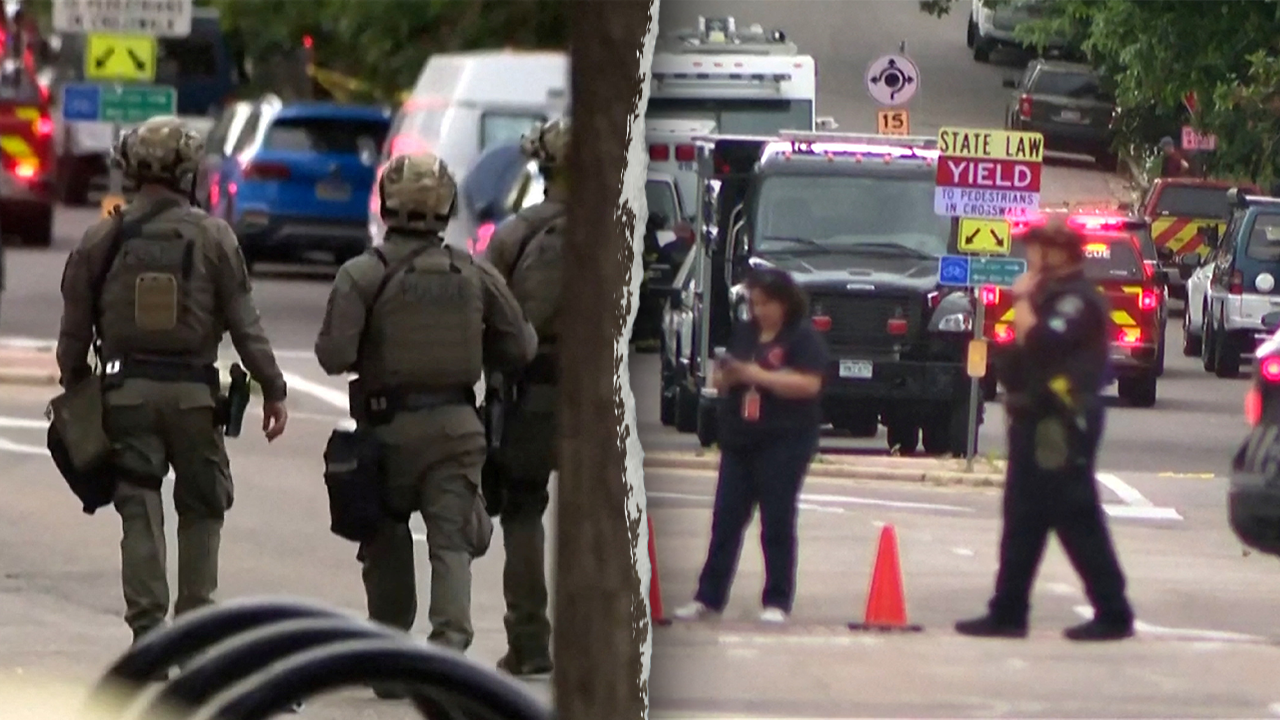West
California Dem compares 'Save Girls Sports' law to Nazi Germany, as two trans athlete ban bills fail to pass

The California state legislature failed to pass two separate bills aimed at protecting girls sports from trans inclusion on Tuesday. During debate for one of the bills, a Democratic state lawmaker compared the proposals to practices employed by Nazi Germany in the holocaust.
California assembly member Rick Chavez Zbur made the comparison while arguing against the first bill, AB 89.
“This is really reminiscent to me of what happened in Nazi Germany in the 1930s. We are moving towards autocracy in this country. In Nazi Germany, transgender people were persecuted, barred from public life,” Zbur said.
Zbur was then interrupted by mediators who protested his comparison and argued it was out of order. But Zbur continued his analogy.
“This is about this, this is about this bill,” Zbur argued. “They were barred from public life. They were detransitioned. They were imprisoned and killed in concentration camps. And the way it started was the same kind of things that are happening in this country by the Trump administration.”
California assembly member Rick Chavez Zbur made the comparison while arguing against the first bill, AB 89. (Getty Images)
California Republican assembly member Kate Sanchez, who proposed AB 89, said she heard audible gasps in the assembly chamber during Zbur’s argument, and that one attendee had to excuse herself from the room.
“There was a lot of gasps and shock,” Sanchez told Fox News Digital.
“It was very tone-deaf. We had a mother who had been in the holocaust itself, so she had to leave the committee hearing because it was so offensive to hear… she stood up and left because she was just so uncomfortable with the situation.”
Multiple Democrat residents, including a member of the LGBTQ community, appeared on the assembly floor Tuesday to advocate in support of the bill.
But AB 89 was ultimately struck down by the Democratic majority. However, it will be allowed for reconsideration at a later date.
“I am just so disgusted that my Democrat colleagues were unable to stand for the protection of women and girls,” Sanchez said. “Not only are they ignoring the will of the people… they’re ignoring the everyday mom, dad, girl in sports. They are ignoring their wants.
Democrat assembly member Avalino Valencia was absent from Tuesday’s vote. Speaker of the Assembly Robert Rivas inserted himself in the committee to vote in Valencia’s absence. Valencia’s office has not responded to Fox News Digital’s request for comment.
Just moments after Democrats struck down Sanchez’s bill, the committee voted on AB 844, which would also ban trans athletes from girls sports and was proposed by California Republican assembly member Bill Essayli. Debate for Essayli’s bill featured testimony from conservative activist and filmmaker Matt Walsh.
NEWSOM’S ‘UNFAIR’ REMARK ON GIRLS’ SPORTS BELIES RECORD AS GOVERNOR: ‘ABSOLUTE BULLS—‘
And like Sanchez’s bill, Essayli’s was also struck down by the Democrat majority. Essayli told Fox News Digital that he believes the Democrat’s resistance to the two bills was intended to send a message to Gov. Gavin Newsom.
Newsom prompted backlash from those in his own party with comments on his podcast last month, expressing his belief that trans athletes in girls sports was “deeply unfair,” but defended allowing it anyway.
“I think there really is a civil war here brewing within the Democrat Party on how to address these issues. You have the governor going in one direction, and I think what you saw today with the leadership in the legislature, which tends to be even more radical and progressive than the governor, taking a completely different approach. And I think they wanted to send a message to the governor that they’re not budging on this issue,” Essayli said.
“Today they wanted to send a message to their progressive, extremist base that they’re not abandoning them.”
The Democratic majority prevented both bills from passing just days after President Donald Trump’s Education Secretary Linda McMahon sent a formal warning to Newsom and the rest of the state, suggesting federal funding may be cut to the state if it continues to enable trans inclusion in girls sports.
MAINE UNIVERSITIES AGREE TO KEEP TRANSGENDER ATHLETES OUT OF WOMEN’S SPORTS AFTER TRUMP ADMIN PAUSES FUNDING
“Allowing participation in sex-separated activities based on ‘gender identity’ places schools at risk of Title IX violations and loss of federal funding. As Governor, you have a duty to inform California school districts of this risk,” McMahon wrote in the letter.
“As Secretary of Education, I am officially asking you to inform this Department whether you will remind schools in California to comply with federal law by protecting sex-separated spaces and activities. I am also officially asking you to publicly assure parents that California teachers will not facilitate the fantasy of ‘gender transitions’ for their children.”

The Democratic majority prevented both bills from passing just days after President Donald Trump’s Education Secretary Linda McMahon sent a formal warning to Newsom and the rest of the state, suggesting federal funding may be cut to the state if it continues to enable trans inclusion in girls sports. (Win McNamee/Getty Images)
The state’s high school sports association, the California Interscholastic Federation (CIF), is currently under federal investigation for potential Title IX violations after several controversial incidents involving trans athletes occurred over the last year.
The CIF was one of the first state athletic associations to announce it would continue allowing trans athletes to compete with girls after Trump signed the “Keeping Men Out of Women’s Sports” executive order on Feb. 5. The CIF stated an 11-year-old state law, AB 1266, which has been in effect since 2014 and gives trans athletes the right to participate in the gender category based on gender identity and not birth sex, for its non-compliance.
Both Sanchez and Essayli told Fox News Digital they expect the Trump administration to amplify its pressure on the state and potentially cut funding in order to enforce the executive order after their bills failed to pass Tuesday.
“I think a lot will come down the pipe over the next week or so,” Sanchez said. “There will be a lot of development from what I’ve been told.”
Essayli envisions a situation playing out in California similar to the one that has been playing out in Maine over the last month, as a public feud between Trump and Gov. Janet Mills has resulted in a hostile back-and-forth between the state and federal agencies over the issue of trans inclusion.
“None of us really went in thinking the Democrats in the legislature were going to change their position on this today, but what we wanted to do is make a clear record, make our arguments and show the world where they stand, where the Democrats stand on this, expose their position on this,” Essayli said. “And I think we accomplished that.”
Follow Fox News Digital’s sports coverage on X, and subscribe to the Fox News Sports Huddle newsletter.
Read the full article from Here

Wyoming
Savvy 13-year-old Teton wolf almost breaks all-time age record – WyoFile

Biologist Ken Mills sensed a shrewdness and smarts in Wolf 840M, a gray male canine that lived longer than any of the other 1,500-plus Wyoming wolves that have been ID’d and tracked since the species was reintroduced to the state three decades ago.
First captured and collared as a 1-year-old living west of Cody in the Ishawooa Pack in April 2012, Wolf 840M had a way of escaping detection and threats for the dozen-plus years that followed.
“Super savvy wolf,” Mills said, summing up an animal that lived 13 years and a few months.
That’s longer than any research wolves from Yellowstone National Park or Minnesota have survived. Only one wild wolf on record — Idaho’s B7, the last animal introduced into the U.S. from Canada in 1995 — lived longer, making it to at least 13.75.
Just two months after being caught in a trap on the east end of the Greater Yellowstone Ecosystem, Wolf 840M, like many young adults, boogied west toward the Tetons. His travels terminated along the mighty mountain range’s western slope, in a sliver of wolf habitat overlooking Teton Valley, Idaho.
There, wolves share the landscape with traps: Wolf trapping is permitted on the west side of the Wyoming-Idaho state line, an invisible boundary that splits the territory used by Wolf 840M’s Chagrin River Pack. (Appreciative U.S. Fish and Wildlife Service biologists let a local resident who reported the west slope Teton wolves name the pack. The person chose to name the pack after a Cleveland, Ohio river.)
“When he was collared, he was caught in a trap,” Mills said. “So he knew what traps were.”

That learned experience and recognition of a life-threatening device — traps killed some of Wolf 840M’s packmates — might have extended his life, Mills said.
Mills learned from experience that Wolf 840M was equally adept at avoiding remote game cameras.
“I’ve been running cameras up there since 2013, and I didn’t get photos of him for a decade, until 2022,” the longtime Wyoming Game and Fish Department biologist said. “I’d have parts of the pack coming through and he would not be there.”
The camera-trap sighting three years ago was a shocker.
Wolf 840M’s first tracking collar died in 2017, five years after he was collared up the South Fork of the Shoshone as a yearling. So by 2022, he would have been 11, already well beyond the typical wolf’s lifespan.
The next winter in 2023, Mills’ contracted capture crew was flying and collaring wolves west of the Tetons when they came upon an animal moving unusually slowly.
“When they were chasing him, he just kind of ambled on downhill,” Mills recalled. “When I got the [dead] collar back, I was like, ‘Oh my goodness, I can’t believe he’s still alive.’”
By this point, Wolf 840M was at least 12. Remote camera footage from around this time — his avoidance skills had evidently waned — showed that he moved around with an old dog’s gait. It wasn’t even a lope.
“Very arthritic,” Mills said.
It’s unclear if Wolf 840M fed himself on the deer and elk herd that dwells on the Tetons’ west slope in his twilight years, or if he relied on packmates. But Mills’ best guess is that his mate, Wolf 1309F, did the heavy lifting, providing for the pack.
“Based on the capture crew’s observations from when they caught him, and the camera footage I have, I’m not sure he would have been able to be fast enough [to catch prey],” Mills said.
The old wolf did still have some spunk, however. He bred 1309F in 2022 and 2023, siring litters at 11 and 12 years old.
Best biologists can tell, Wolf 840M succumbed to old age. Wyoming Game and Fish’s contracted pilot picked up a mortality signal flying last July. Mills went to investigate the site and quickly found the carcass.
“The pilot was 9.5 yards off,” Mills said of the impressively accurate coordinates he trekked toward marking the remains. “She’s nuts.”

By the time Mills got to him that summer, keeled over right next to a small spring, Wolf 840M’s remains were pretty well melted back into the ground in the west slope Teton territory, where he spent almost his entire life.
That’s a pretty remarkable landscape for a wolf to exist at all, let alone to survive until 13 years and change.
“They’re on the edge of a human-dominated landscape,” Mills said.

Wolf 1309F — Wolf 840M’s former mate — even sometimes crosses Teton Valley, Idaho, passing by towns like Victor and navigating subdivisions, a highway and the Teton River to access hunting grounds in the Big Hole Mountains.
Mills repeated his earlier observation.
“Super savvy wolves,” he said. “Most people don’t know they’re there.”
West
Never-before-seen photos reveal WWI-era submarine 1,300 feet below surface where 19 sailors perished in 1917

NEWYou can now listen to Fox News articles!
In Dec. 1917, 19 sailors serving on a World War I-era U.S. submarine made the ultimate sacrifice during a training mission.
Perhaps fittingly, scientists have captured never-before-seen photos of its watery resting place off the California coast just ahead of Memorial Day.
The U.S. Navy submarine, USS F-1, went down after a collision with its sister ship on Dec. 17, 1917, and now sits 1,300 feet below the surface on the ocean floor off San Diego.
MYSTERIOUS 18TH-CENTURY WARSHIP UNEARTHED AT GROUND ZERO SITE GETS NEW HOME
“It was an incredibly exciting and humbling experience to visit these historically significant wrecks and to honor the sacrifice of these brave American Sailors,” Naval History and Heritage Command (NHHC) Underwater Archaeologist Brad Krueger said in a statement.
“All of us at the NHHC are grateful for this collaboration, which also enabled us to document and assess the condition of the crafts.”
In Dec. 1917, 19 sailors serving on a World War I-era U.S. submarine made the ultimate sacrifice during a training mission. Shown above, a photogrammetric reconstruction of the submarine USS F-1 on the seafloor west of San Diego. (Zoe Daheron; Woods Hole Oceanographic Institution)
The Naval History and Heritage Command’s mission is to preserve and present an accurate history of the U.S. Navy.
From Feb. 24 to March 4, researchers with the Woods Hole Oceanographic Institution (WHOI) used its human-occupied submersible Alvin, and an autonomous underwater vehicle known as Sentry belonging to the National Deep Submergence Facility, to capture close-up images of the wreck.
AMERICANS SHOULD HONOR MEMORIAL DAY IN THIS WAY, MILITARY SERVICE MEMBERS SUGGEST
“As a Navy veteran, making this dive — together with another Navy veteran and a Navy historian — was a solemn privilege,” said Office of Naval Research Program Officer Rob Sparrock, who was in the submersible as it when it surveyed the submarine.
“Lasting nearly eight hours, there was time to contemplate the risks that all mariners, past and present, face. sIt also reminded me of the importance of these training dives, which leverage the knowledge from past dives, lessons learned and sound engineering.”

A hole in the hull of USS F-1 was caused by a collision with its sister ship, USS F-3. (Bruce Strickrott; Woods Hole Oceanographic Institution)
While studying the submarine, the scientists also surveyed a Navy torpedo bomber training aircraft that went down in the same place in 1950.
“Advanced ocean technology and simple teamwork played a big part in delivering these new images,” said WHOI’s Bruce Strickrott, manager of the Alvin Group and the sub’s senior pilot who helped lead the expedition.
“It was a profound honor to visit the wreck of the F-1.”
“Once we identified the wreck and determined it was safe to dive, we were able to capture never-before-seen perspectives of the sub.
For more Lifestyle articles, visit foxnews.com/lifestyle
“As a U.S. Navy veteran, it was a profound honor to visit the wreck of the F-1 with our ONR and NHHC colleagues aboard Alvin.”

Photogrammetric reconstruction of the submarine USS F-1 shows the conning tower and collision damage that caused the sub to sink. (Zoe Daheron; Woods Hole Oceanographic Institution)
Surveying the submarine involved seven dives that were part of a planned training and engineering mission to give submersible pilots-in-training practical experience.
The team held a remembrance ceremony for the lost sailors, ringing a bell 19 times on the research vessel Atlantis directly above where the submarine lies.

While studying the submarine, the scientists also surveyed a Navy torpedo bomber training aircraft that went down in the same place in 1950. (Anna Michel; Woods Hole Oceanographic Institution)
“History and archaeology are all about people and we felt it was important to read their names aloud,” Krueger said.
“The Navy has a solemn responsibility to ensure the legacies of its lost sailors are remembered.”
Advanced imaging technology helped the team document the wreck, including multibeam sonar systems on the Atlantis and Sentry that produced detailed, high-resolution maps of the submarine.

External ship’s wheel located on the sail of USS F-1 (Bruce Strickrott, Woods Hole Oceanographic Institution)
That allowed the team to reconstruct the wreck using photogrammetry to make 3-D models.
“While these depths were well within the dive capability for Alvin and Sentry, they were technical dives requiring specialized expertise and equipment,” said Anna Michel, NDSF chief scientist and co-lead of the expedition.
“We were careful and methodical in surveying these historical sites so that we could share these stunning images, while also maintaining the reverence these sites deserve.”
Read the full article from Here
San Francisco, CA
First women's sports bar in San Francisco opens this week

A women’s sports bar is coming to San Francisco.
Rikki’s on Market Street will officially open its doors on Wednesday.
The restaurant and bar owners said they decided to open the first-of-its-kind bar in San Francisco out of frustration. They said they couldn’t find any bars that would play professional women’s soccer or basketball games.
The bar’s name honors the late Rikki Streicher. She was a community activist and leader in San Francisco’s LGBTQ movement in the 1960s. She also co-founded the Federation of Gay Games in 1982.
-

 Politics1 week ago
Politics1 week agoMichelle Obama facing backlash over claim about women's reproductive health
-

 Technology1 week ago
Technology1 week agoOpenAI wants ChatGPT to be a ‘super assistant’ for every part of your life
-

 Movie Reviews1 week ago
Movie Reviews1 week agoThe Verdict Movie Review: When manipulation meets its match
-

 West3 days ago
West3 days agoBattle over Space Command HQ location heats up as lawmakers press new Air Force secretary
-

 Finance1 week ago
Finance1 week agoHere's what will boost your feeling of financial well-being the most, researchers say
-

 Technology1 week ago
Technology1 week agoWhy do SpaceX rockets keep exploding?
-

 World1 week ago
World1 week agoTwo killed in Russian attacks on Ukraine before possible talks in Turkiye
-

 Kentucky1 week ago
Kentucky1 week agoHow Ole Miss baseball’s pitching options will factor in elimination game vs Western Kentucky













